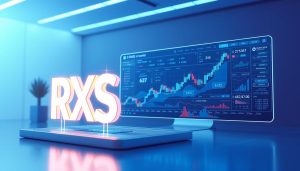Imagine this: 95% of crypto traders lose money. This shows the tough learning curve and risks in cryptocurrency1. Yet, for the daring, it’s a chance to use special strategies for fast-changing markets.
The excitement of online trading and quick market changes needs understanding and adaptability. “Lunatic” methods can make volatility profitable. You need to know when to change tactics and use advanced analyses. Services like Kana Trade help by offering quick settlements to take advantage of market swings2. Staying disciplined and up-to-date with trends and technology is key.
To do well in dynamic markets, you must understand trading well and be mentally tough. Platforms like Kana Trade, along with Econia, start a new phase of fast, open crypto trading. This lets traders keep control while dealing with quick market shifts2. Being skilled in these methods and using them wisely is the difference between winning and losing in such an unstable setting.
Key Takeaways
- 95% of crypto traders face losses, showing the importance of smart strategies1.
- Quick settlements can greatly affect trading success2.
- It’s crucial to adapt to market changes and keep up with trading trends.
- Lunatic strategies rely on disciplined yet flexible approaches to profit from market volatility.
- Platforms with cutting-edge tech, like Kana Trade, give traders more control and speed2.
Introduction to Lunatics Trading Strategies
Welcome to the exciting world of Lunatics Trading Strategies. Here, you can learn the art of doing well in fast-moving markets. Whether you’re just starting or you’re already trading, this guide has helpful insights.
The Lunatics Trading Strategies are carefully built from scratch. They’re based on deep market analysis and backed by real financial data. For example, Terra raised $32M in 20183, and then $25M more in 2021 to grow its innovations and adapt to the market. Terraform Labs also got $150M from top firms like Pantera Capital3.
Lunatics’ day trading shines in up-and-down markets. It uses stats and smart trading thought3.The Terra ecosystem uses Luna for governance and UST for stability. This balance is key for good trading.
It’s important to keep learning and staying current. Resources, market analysis, and knowing both basics and complex analysis are key. Terraform Labs’ $150M shows how crucial funds and readying are3. Varying your strategies and adapting with the trends also helps a lot.
The community plays a big role in trading success. In Korea, 5% use Chai and in Mongolia, 2% use Memepay within the Terra network3. Also, traders get to explore with the release and vesting of $LUNA tokens4.
Try these trading methods and see if they fit your investment aims. Use solid data, keep learning, and stay smart in trading to succeed in changing markets. Dive in and use these strategies to make your trading exciting and rewarding. For extra tips and community help, check out the Solana Trading Bot Community. Equip yourself for successful trading.
Understanding the Dynamic Markets
The financial markets are always changing. They move with global events, tech upgrades, and new rules. Understanding these parts is key to analyzing the markets well.
Events like Muhurat Trading show how old traditions and markets mix. This is a special trading time on Diwali. It marks the Hindu New Year’s start. People from all levels come to invest, hoping for a lucky and prosperous year5.
Knowing more about finance helps you see and use market trends. With this knowledge, you can change your investment plans at the start of the Hindu New Year, aiming for a better outcome5.
Cryptocurrency markets also shape overall market conditions. For example, Luna Classic’s (LUNC) value shows this clearly. If LUNC’s price hits $0.001, its worth would be $6.9 billion. This would make it the 14th biggest cryptocurrency6.
If its price goes up to $0.01, LUNC would be the third biggest, after Ethereum and Bitcoin6. Knowing these details helps you analyze the market better and find good investments.
Grasping the shifts in dynamic markets and improving your financial know-how is crucial. It lets you do well in the changing world of cryptocurrency markets and more.
Essential Day Trading Strategies for Beginners
Starting in day trading can seem hard. But beginners can learn to navigate its quick pace. We’ll look at three key strategies: scalping, momentum trading, and breakout strategies.
Scalping
Scalping suits those quick to decide. This method is about many trades for small price gains. It focuses on short changes, cutting risk and exposure. It’s about watching trends by seconds and minutes. Tools like trading simulators become handy here7. Traders update their charts frequently to catch each chance7.
Momentum Trading
Momentum trading targets big price moves. It means picking stocks on an up or down trend. Watch ratios and indicators to find these trends7. Talking with seasoned traders boosts your learning7. There are over 2,300 day trading videos for skill improvement7.
Breakout Trading
Breakout strategies chase stocks passing key levels. Spotting these moments means catching big moves. Take buying a bouncing-back stock, for example8. Spread your buys over weeks to beat volatility8. This helps you stay steady and deal with market shocks.
| Trading Strategy | Key Focus | Tools & Tips |
|---|---|---|
| Scalping | Short-term price changes | Use trading simulators, monitor charts in small increments |
| Momentum Trading | Significant price movements | Engage with traders, watch educational videos |
| Breakout Trading | Breaking resistance/support levels | Buy dips, stagger investments |
Using these methods can guide you to market success. Always stay updated and polish your strategies with new insights and trends.
Stock Market Tips for Dynamic Environments
Navigating dynamic markets calls for smart, informed moves. Here are key tips to help you do well:
Set Clear Goals: To do well in online trading, set goals that are clear and reachable. These goals will help steer your trades and keep you on track with your long-term plans.
Adopt a Consistent Approach: Being consistent matters a lot in fast-changing markets. Make a plan for trading and stick to it, even when markets shift. This will keep you from making quick, unplanned moves and better your market analysis.
Conduct Thorough Research: Keep up with the latest market trends and news. Deep research and ongoing learning are key to making smart choices. Use books, blogs, and financial newsletters to stay current with the market9.
Utilize Risk Management Tools: Use risk management tools like stop-loss orders to shield against market surprises. Tools like CVEX’s Clearance Bots help lower risks of sudden market changes10.
Using these pointers will make you more flexible and tough in a changing stock market. Staying focused on clear goals, steady strategies, and solid research, you can move through online trading’s challenges and improve your investing approach.
Mastering Algorithmic Trading
Mastering algorithmic trading is about learning to use automatic systems for trading. These systems trade based on set rules. It’s a rewarding area that changes how you trade, using quick actions and cutting out emotional choices.
What is Algorithmic Trading?
Algorithmic trading uses computer algorithms to trade automatically. These algorithms are in advanced software. They sift through lots of market data to find good trading chances. Whether it’s mean reversion or momentum strategies, the main aim is to make trading more efficient with automation.
Benefits of Algorithmic Trading
The benefits of using algorithmic trading are many:
- High-frequency trading takes advantage of small price changes quickly, boosting profits.
- Backtesting lets you test automated trading strategies with past data to see if they work.
- Algorithmic trades make up a huge part of stock trading now, showing their important role11.
Popular Algorithms for Trading
There are several key algorithms traders use:
- Mean Reversion: This believes prices will go back to their average, spotting buy or sell chances.
- Momentum: Targets assets moving strongly in one direction to make gains in fast trading settings.
- Arbitrage Strategies: Uses price differences in markets to make money on the price gap.
Books like “Algorithmic Trading: Winning Strategies and Their Rationale” explore these strategies deeply. They give tips for better trading algorithms11. “The Evaluation And Optimization Of Trading Strategies” by Irene Aldridge is also a great read. It aids traders in improving their automated strategies11.
Using algorithmic trading can boost your trading efficiency. It lets you enjoy automated strategies and stay ahead in fast markets.
Investment Advice for Lunatics
When diving into investments fit for Lunatics, diversifying is key. It’s important to look at how different assets relate to each other. Since the value of cryptocurrencies can change quickly, spreading your investments can lower risks12. You’ll also need to stick to strict risk management rules.
It’s crucial to set specific financial targets. For example, one investor spread their money across 13 coins. They hoped for a 10% return but ended up with 28% in just seven weeks13. This shows how spreading your investments can really pay off.
Being careful is vital, especially with decentralized exchanges like Pancake Swap12. Double-check you have the right contract address to avoid scams and protect your money.
Sticking with a long-term plan through all market changes is super important. On average, markets often adjust by 8-20% yearly. Larger adjustments of 20% or more happen every four to five years14.
Adjusting your trading approach to keep up with market shifts is a must. Remember, the market typically grows two years out of three14. This fact underlines why it’s so important to stick with your investment plan, even when times are tough.
Lastly, consulting a financial adviser who uses a proven, long-term strategy is wise. It takes decades to see if an investment plan really works14. So, patience and informed decisions are essential for successful investing.
The Importance of Market Analysis
To make smart trading choices, analyzing the market is key. It can involve looking at technical, fundamental, and sentiment analysis. These methods help us understand the market better.
Technical Analysis
Technical analysis means examining charts and statistics to guess where prices will go. It identifies trends and when they might change. This makes trading plans more accurate. For instance, studying lunar cycles offers insights on market trends. From 1950 to 2009, trading based on lunar cycles could have turned a small investment in the S&P 500 into something 21 times larger during positive lunar phases15.
Fundamental Analysis
With fundamental analysis, traders look at financials and broader economic signs. They consider things like company earnings and global events. This helps determine an asset’s true value. Actions by central banks, for example, can affect stability, showing why in-depth analysis is necessary16.
Sentiment Analysis
Sentiment analysis measures market mood. This mood can sway asset prices. It examines how traders feel and behave to forecast market changes. Market moods, like the “Buy The Fing Dip” belief, greatly influence markets16. Conservative trading that matches this sentiment can yield steady gains. A look at Apple’s weekly data revealed a 1.4% profit from seven trades17.
Using a mix of technical, fundamental, and sentiment analyses makes for thorough market study. Each has its strengths. Together, they improve how we make trading decisions15. Studies show blending these methods, with a good grasp of market mood, boosts trading success market analysis.
Developing Financial Literacy for Traders
For traders to do well, understanding the market is key. They need to grasp basic concepts and use tools and strategies effectively. For example, knowing how bank loan holders get lower returns compared to others can help in decision making18.
Learning about finances teaches important tips. It tells you to limit your trade sizes. This way, if you lose ten times in a row, you only lose 10% of what you have19. This helps you trade wisely using various tools and knowledge.
Keeping up with new financial news and tech can really boost your trading. Traders close to the market during the South Sea Bubble were more likely to borrow. This shows location can affect how people trade18.
Also, spreading your investments, like in 13 different coins, can decrease risk and increase gains. One strategy brought a 28% gain in seven weeks13.
Knowing market trends can make trading better. For instance, people borrow more when stock prices are high. This shows being timely and aware of the market is crucial18. Solid financial knowledge lets you use trading tools more effectively.
| Concept | Insight | Actionable Tip |
|---|---|---|
| Loan Holder Behavior | More likely to buy following high returns18 | Be cautious of buying trends and high returns |
| Risk Management | Limit each trade to 1% of equity19 | Implement stringent risk management strategies |
| Diversification | Investing in diverse assets can yield 28% return13 | Diversify investments to balance risk and reward |
The Role of Trading Psychology
Trading psychology is key to becoming a successful trader. It’s about how feelings like fear, greed, and hope affect your decisions. Learning to control these emotions helps you make better, logical choices in fast-changing markets.
Understanding Trading Psychology
Getting trading psychology means knowing how feelings influence your trades. Fear might make you leave good trades too early. Greed can lead to holding onto wins for too long, risking profits. Even market trends, including lunar cycles, impact trades. Studies show stock returns drop about 4% to 5% around full moons versus new moons20. This shows managing your behavior is key in trading.
Managing Emotions While Trading
To control emotions, set clear rules and follow them. Use automated systems when possible. Like stop-loss strategies, they help handle sudden market changes. Most successful traders stick to pre-set stop loss levels, between 1% to 5%, based on risks and market conditions21. Keeping a tight rein on emotions and market trends leads to more stable profits.
Adding emotional discipline to your strategy improves results. “Momo Traders” says successful home traders value independence and freedom22. This freedom lets them tailor strategies to their emotional wellbeing. It lays the foundation for lasting success.
Managing emotions sets successful traders apart. Focus on trading psychology, emotional discipline, and controlling your behavior. This gives you an edge in the competitive trading world.
Risk Management Strategies
Effective risk management strategies protect your investments. Begin by conducting a thorough risk assessment. It reveals possible dangers and market situations. Tailoring strategies to different situations becomes easier with this knowledge.
Use stop-loss orders to limit losses. This ensures you proactively manage your risks16. Spreading your bets through portfolio diversification also helps. It reduces risk and keeps your investment strategy balanced.
It’s crucial to watch how much you borrow. Too much leverage increases your loss risk. Keep an eye on your exposure. Stay updated on market trends. Adjust your strategies to protect your money effectively23. Even though risk management can cost more, the reduction in losses makes it worthwhile16.
Crafting stop-loss strategies for different situations is key. Traders often use spread strategies for better risk-reward balances16. Aiming for a profit probability of 35% or more is ideal. In such cases, the best outcome from a spread should be doubling your money16.
The story of LTCM teaches the value of solid risk management. After facing losses, LTCM reduced its risk significantly23. Their heavy reliance on value-at-risk numbers highlighted the need for diverse risk assessment methods.
Adjusting your strategy based on market changes is part of risk management. Review your financial performance periodically. This keeps your strategies in line with your investment goals and risk appetite.
Leveraging Cross Margin Trading
Cross margin trading is key for those into complex market moves. It lets traders use their whole account balance, lowering the needed margin for a mix of investments. By using cross margin trading at places like Crypto Valley Exchange (CVEX), you can make your margin better. This improves your trading approaches.
What is Cross Margin Trading?
Cross margin trading lets you use all the money in your account to stop positions from being closed. This method cuts down the need for separate margins for each trade. This makes managing your investments easier. For instance, CVEX offers a big cut in the total margin required compared to single trades10. This is really good for traders who hedge their trades well. It lowers risk and frees up more money for trying new things and diversifying10.
Benefits of Cross Margin Trading
One big plus of cross margin trading is better margin thanks to pooling funds across several trades. This lets you use your money better and enhance your margin strategies. On CVEX, futures contracts are released every month and last for three months. This means there are always three futures available24. Also, CVEX supports big networks like Ethereum and Arbitrum. This makes USDC transactions easy on its platform24.
Cross margin trading also gives you top-notch risk management. CVEX keeps an eye on portfolios, checking collateral, gains, and losses. This helps balance trading goals with the market’s ups and downs10. They have Clearance Bots that kick in during high-risk times to start the liquidation process10. This keeps your trading smooth and safe, showing why managing your portfolio well is vital.
How to Improve Your Trading Discipline
Getting better at trading discipline is key for long-term wins. Work on sticking to your plan and staying calm. This helps you avoid making decisions based on emotions and keeps you focused.
Top traders stress the need for good habits. For instance, checking daily and weekly data helps spot important trends25. This method cuts down stress and boosts your performance by letting you see the big picture without getting lost in daily ups and downs.
Using smart risk management is vital. Putting stop-loss orders and risking only 1–2% per trade keeps big losses away26. Paper trading is another way to polish your skills without real money at stake26.
For those in fast-moving markets, like penny stocks, it’s crucial to cut losses fast. Keeping your goals real is important, as even Wall Street targets 8%–10% yearly returns27.
Staying disciplined also means knowing your strategies well. Traders like Matthew Monaco and others show how adapting to your style and following rules can boost your account. Avoid trading too much or following the crowd blindly to safeguard your trading career27.
Sticking strictly to your strategy and maintaining self-control aligns with your trading plan. This leads to wiser decisions and a sharper trading discipline. A regular routine and adherence to your chosen method makes navigating the markets easier.
Advanced Trading Techniques for Pros
We’ll dive into complex trading techniques that expert traders use to make the most of the market. They focus on arbitrage and pair trading to find and use market inefficiencies. Understanding the market deeply, timing each move precisely, and managing risks wisely are key.
Arbitrage Strategies
Arbitrage involves buying and selling an asset in different markets to profit from price differences. Traders spot and use these short-lived arbitrage chances to earn nearly risk-free money. This method requires quick action and the ability to spot price changes as they happen. It’s all about fast transactions and using advanced tools to quickly identify and act on these opportunities.
Pair Trading
In pair trading, traders buy and sell two linked assets at the same time. They do this to profit from their relative movements. This approach, also called statistical arbitrage, uses the historic relationship between two assets. Traders carefully study this correlation to find potential discrepancies. The skill in this method is in how it’s executed and keeping a close eye on how the assets move together or apart.
To succeed with these advanced trading techniques, traders need a deep market understanding and advanced tech tools. For example, traders like Mr. Brandon Battle have significantly grown their wealth, reaching $12,000 in a few months, by using these strategies effectively in the ever-changing market28.
















